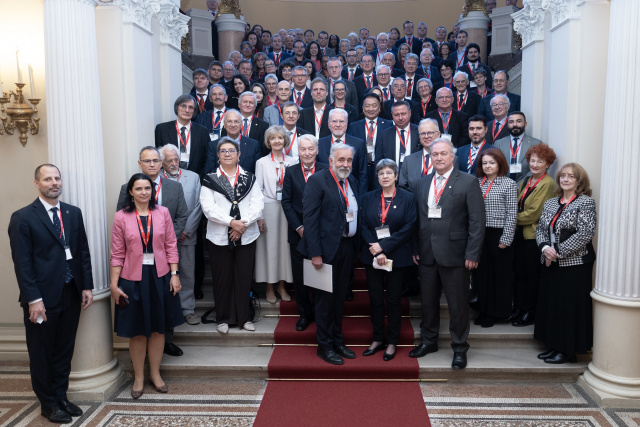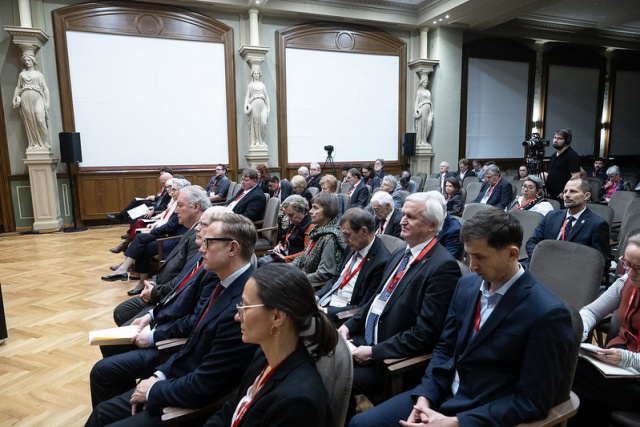MTA 200th Anniversary International Conference
The year 2025 marks a special year in the history of the Hungarian Academy of Sciences: this year MTA celebrates the 200th anniversary of its foundation. Two hundred years ago, on 3 November 1825, Count István Széchenyi offered one year’s income of his estates for the purposes of establishing a Hungarian Learned Society.
Széchenyi’s example was followed by members of the aristocracy and committed citizens alike, and through their noble acts the Hungarian Academy of Sciences was founded by the force of public will as a national institution to pursue sciences and arts and to cultivate the Hungarian language. With more than 19,000 members of its public association today, the Hungarian Academy of Sciences represents the Hungarian scientific community, and serves as the cornerstone of scientific quality and research ethics.
 On November 3rd, 1825 at the district session of the lower house of the Pozsony Diet, Pál Felsőbüki Nagy, a leading figure of the estate-opposition raged against the top aristocrats who were criminally disinterested in national culture or the native tongue. Still under the influence of this reproach, from the rows of those listening, „Young Count Széchenyi, Hungarian mounted captain made this recommendation: Dear Statuses and Estates! Although I am in no way great, still I am wealthy; that is why I recommend a whole year’s portion of my income to augment my national language, so that the channeling and ordering of that should depend on the nation’s diet.”
On November 3rd, 1825 at the district session of the lower house of the Pozsony Diet, Pál Felsőbüki Nagy, a leading figure of the estate-opposition raged against the top aristocrats who were criminally disinterested in national culture or the native tongue. Still under the influence of this reproach, from the rows of those listening, „Young Count Széchenyi, Hungarian mounted captain made this recommendation: Dear Statuses and Estates! Although I am in no way great, still I am wealthy; that is why I recommend a whole year’s portion of my income to augment my national language, so that the channeling and ordering of that should depend on the nation’s diet.”Count István Széchenyi’s historical act was commemorated with a three-day international event between 3–5 November 2025, with more than a hundred international guests in attendance, including presidents of academies, heads of scientific councils, and science policy experts.
3 November 2025
On 3 November, a scientific conference titled “200th Anniversary of the Hungarian Academy of Sciences – Hungarian–Slovak Scientific Relations in the Past and Present of the Academy” was held in Bratislava, Slovakia. The event was co-organised by the Slovak Academy of Sciences, the Hungarian Academic Council of Slovakia and the Hungarian Academy of Sciences, where Prof. Tamás Freund, President of the Hungarian Academy of Sciences, and Prof. Martin Venhart, President of the Slovak Academy of Sciences, delivered addresses at the opening of the commemorative conference at the University Library in Bratislava. The venue was of particular historical significance because the National Assembly of Hungary, where Count István Széchenyi performed his noble act, took place in Bratislava.
On the evening of 3 November, a bicentennial commemorative concert and reception were held at the Liszt Ferenc Academy of Music. The programme of the concert featured the Academic Festival Overture by Johannes Brahms, István Széchenyi from the Historical Hungarian Portraits by Franz Liszt, and Symphony No. 7 in A major, Op. 92 by Ludwig van Beethoven.
4 November 2025
On the morning of 4 November, an international conference was held on the theme “Past, Present and Future of Learned Societies: The Changing Role of Academies in the 21st Century”.
The first session was dedicated to “200 Years of the Hungarian Academy of Sciences”, reflecting on the vast history and reinvigorated mission of the institution. The session was followed by a panel discussion titled “The Changing Role of Academies in the 21st Century”. It brought together leaders of national and international academies to explore their response to societal change and the evolution of science, their respective approaches to supporting the careers of new generations of scientists, the challenges of misinformation and retaining public trust, and their ways of reshaping their research activities or providing science advice.
In the afternoon, a high-level workshop was held by SAPEA and ALLEA (European Federation of Academies of Sciences and Humanities).
The event focused on “Upholding Integrity in Scientific Advice: Key Principles and Challenges,” and allowed participants to discuss the role of academies in the process of policy-making and examine the most effective means of validating expert opinions and positions based on scientific evidence.
5 November 2025
On 5 November, the Academia Europaea Budapest Knowledge Hub hosted a symposium titled “From Barriers to Bridges: Towards a More Cohesive European Research Area”.
The symposium aimed to highlight the current situation of “widening” as a concept of EU research policy and discussed the possible need for the reform of its instruments with a view to fostering scientific excellence in then underperforming regions and creating a more cohesive and competitive European Research Area (ERA). After respective presentations by representatives of the European Commission on the upcoming framework programme and the recommendations of stakeholder organisations, in the second part of the event, panellists were invited to share their views and suggestions aimed at improving EU RDI performance and competitiveness by achieving a more balanced distribution of funding for excellent research across Europe.
At the same time, an exhibition titled Treasures of the 200-Year-Old Academy opened at the Palace of the Hungarian Academy of Sciences, including the permanent exhibition of the Academy’s Art Collection, as well as manuscripts and artifacts of national significance from the Library and Information Centre of the Hungarian Academy of Sciences.


